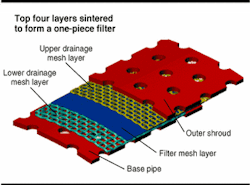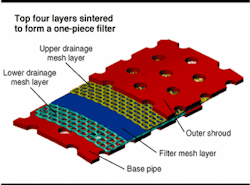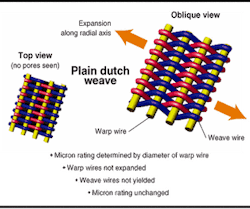EXPANDABLES TECHNOLOGY: Halliburton sandscreens market entry rounds out Enventure offering
Borrowing from Shell's licensed intellec-tual property, Halliburton has launched its own line of expandable sandscreens, filling out the company's offering of expandable products. Enventure, which is a 50-50 joint venture between Shell and Halliburton, has performed all of the solid expandable jobs to date, but Weatherford has installed all the expandable sand screens. While Weatherford is developing its own line of expandable solids, Halliburton has launched PoroFlextrademark, Expandable Screen completion Systems.
The major difference between the existing expandable sand screens and those that Halliburton has developed is that Halliburton does not use slotted tubulars. The base tubular used in the company's design is very similar to the tubular used by Enventure for its expandable solids work. The pipe is perforated, but its physical strength is more like regular casing (solid pipe) than like slotted pipe, according to Travis Hailey, Sand Control Product Manager, Halliburton Energy Services.
Product structure
The pattern of these perforations is critical to the success of the expansion, added Hailey. Welded to the perforated sections of these tubular pipes is the sand filter component of the screen. Randy Simonds, Senior Product Champion with Halliburton Energy Services, said the component was made from a filter mesh sandwiched between lower and upper drainage mesh layers and encased in a perforated outer shroud.
The layers that make up the sand filter are produced in flat sheets and bonded to the outer shroud and are then formed into tubes. This assembly is welded to the base pipe over the perforations. All of the different layers are carefully aligned, so that when the tubular is expanded - as much as 21% - the filtration properties of the screen remain intact and the tubular has a good seal with the open borehole.
Once the filter component is attached to the perforated base tubular, it can be handled in the same manner as any tubular. These joints are made up with threads and can be combined to offer sand control over very long production intervals.
While the base material of the PoroFlex screens borrows from Shell's core technology, Hailey said the screens are expanded top down, as opposed to the Enventure solids, which are expanded bottom up. Although Halliburton limits the expansion of this product to 21%, Hailey said, in tests, the tubulars has been expanded beyond this point. The key in these downhole applications is reliability for the life of the well. Because of this, Hailey said, very conservative expansion numbers are used.
Filter design
The filtration media is a sintered laminate made up of multiple layers of wire mesh, fused into one material based on Purolator's PoroplateRegistered (registered trademark of Purolator Facet, Inc.) design.
A critical component of expandable screens is that the micron rating remains consistent when the screen is expanded, Simonds said. This is accomplished by using a series of warp wires, running vertically, around which are threaded weave wires in a simple over-one, under-one, plain Dutch weave pattern.
The resulting fabric has openings only at the angle where the weave wire goes around the warp wire. The diameter of the warp wire dictates the size of the opening, which is reflected in the micron rating. When the screen is expanded, the size of this opening is not affected.
While critical to the design, Hailey said this is not a unique filter media, and has been used on other products. However, it is necessary that the tubular be expanded uniformly, which is where the Enventure technology comes into play. Hailey said the PoroFlex screens are essentially the marriage of several existing technologies - Halliburton and Purolator's sintered laminate media and Enventure's solid expandable tubulars. There are other technical developments that make this union a success, he said.
The weld that first converts the filter from a flat sheet to a tube has to be made in one pass to work properly, as do the welds that attach the screen section to the base pipe. The technique that fuses the different layers of the filter can minimize erosion and avoid unraveling of the material. This one-piece, sintered filter is welded to the base pipe using a material with the proper ductility to accommodate the expansion process. With the entire filter fused into one piece of material, many hazards, and potential leak paths, can be avoided.
Expansion process
One challenge of the top-down expansion method is the fact that it shrinks the length of the sand screen slightly. It is thus important to determine precisely how long the screen needs to be after it is expanded, so the difference can be made up in the original length.
Beyond expanding top down, Simonds said Halliburton's expansion process is different from that used by Enventure. Force is applied to the expansion tool using a hydro-mechanical jack that drives the expansion cone down in discrete strokes.
The current design has a stroke length of about 10 ft, but Simonds said this may be extended in future designs. Although the stroke is not very long, the cone moves quickly, about 2.5 ft/sec. The overall expansion is not this fast, but the stoke itself is just a component of that total.
The jack is a one-piece assembly, which is recovered once the expansion is complete. The jack is landed into a seal bore which breaks circulation to the surface, indicating the expansion process is complete. At that point, additional pressure is applied from the surface, sheering the supports that hold the tool in place. The expansion cone then collapses to a diameter that can be retrieved to the surface. Nothing is left in the wellbore, Simonds adds.
Field ready
With testing complete, Simonds said the PoroFlex system is ready for its first application, more than likely offshore. "We have screens on the ground and expansion tools ready to go," he said. All that's missing is a well that fits the needs of the product's first application. It is critical, as with any new technology, for the first application to be chosen carefully. Simonds said the goal is not only to complete the job successfully, but to increase the operator's confidence in the technology for future work.
While dozens of expandable sand screens are in place, Simonds said the North American market is still wide open. This technology has been designed with an eye to applications in the Gulf of Mexico and other sand control markets globally. Simonds said the ideal application is a high-cost well where the risks were high and so were the rewards. This would allow the technology to be put to its best use.
Regardless of where the first application is made, Simonds is confident there will be a large market for these screens. He has heard estimates that expandables could one day be used in up to 45% of the wells now serviced with gravel pacs. "The product is really in its infancy now," he said.


